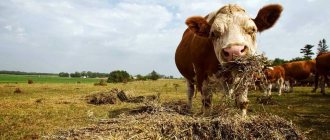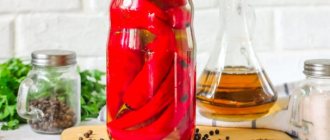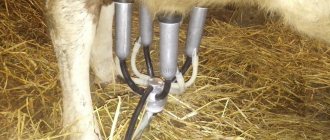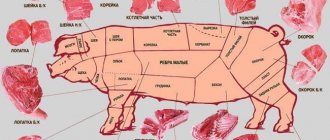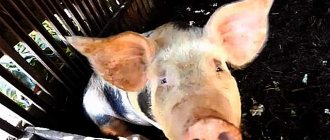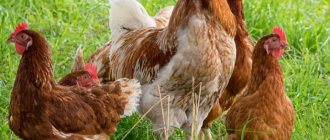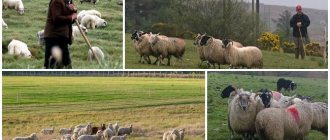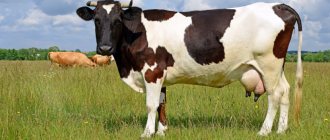The goat is a ruminant animal.
Therefore, feeding her will not be difficult.
In winter, its main food is hay, and in summer, grass.
But besides this, additional complementary foods must be included in the diet of this animal.
It must contain essential vitamins. Dairy breeds produce up to eight liters of milk per day and, accordingly, spend a lot of energy. Therefore, it is necessary to feed the goat not only abundantly, but also correctly.
And for this, you need to determine: what quantity and quality of food is required and how much hay the goat needs for the winter.
How much hay does a goat need?
At first it may seem that feeding a goat is quite difficult, since it eats quite a lot. The proverb “As you feed, so will you milk” applies well to goats. In fact, the animal's productivity covers all costs well.
The main, but not the only nutritious product for goats in winter is hay. Therefore, in order not to run around in search of hay in winter, it is better to take care of this in advance.
Of course, every goat has its own needs. But on average, one animal in winter will require from four hundred to six hundred kilograms of product. A dairy goat will need approximately two kilograms of hay at a time. This animal is fed 2 times a day.
It is not difficult to calculate that one goat will eat 4 kilograms in a day, and in 30 days (30 * 4) = 120 kg. Just in case, it is better to stock up on an extra 100 kilograms for each individual. Winter stocks must be made on a per-head basis.
Bale of hay for goats
Breeding goats expend more energy and will therefore require increased nutrition.
An adult will need about 6 kilograms per day.
Young animals will eat about one and a half kilograms of hay each day.
Therefore, before calculating the amount of hay, you should calculate how many animals are in the stall.
Important Tips
Goats can produce milk by eating straw alone, but this approach is unacceptable. It is important to think about productive longevity and high milk yield. Therefore, monofeeding is not encouraged on the farm.
There are other important tips to consider before feeding your goat in winter:
- On average, the daily volume of feed is 2 kg of dry food and products, 2 kg of succulent food and 0.5 kg of concentrate.
- Accustoming a goat to an appropriate diet should be gradual. In the mornings at the end of spring, the animal begins to be fed hay, giving less greenery.
- If the goat gains a lot of weight and becomes less active, you need to reconsider the structure of the diet. Perhaps the artiodactyl is overfed with concentrates. It is worth reducing the proportion of grain by 100-200 g.
- Excess concentrates can cause urolithiasis, so it is important to choose feeds that are balanced in composition. At the first signs of the disease, substances rich in phosphorus are removed from the diet, and the amount of vitamins, zinc, copper, cobalt, and manganese is increased.
The main mistake in feeding a goat in winter is limiting food and sudden changes in diet. It is important to ensure a balanced diet and provide the animal with all the necessary vitamins and minerals.
How to prepare the required quantity
Preparing goat feed
Before preparing hay, you should carefully study which herbs may be beneficial for your goat.
In some cases, a bitter taste may appear in the milk if there is wormwood, mustard or horsetail in the hay.
If a farmer mows his own hay, he should know that this should be done before the grass begins to flower.
At this time, they retain a whole storehouse of useful substances. After the grass has bloomed, it not only loses essential vitamins, but also becomes very rough.
Key points about mowing:
- All cereal plants should be mowed during the heading period.
- Legumes begin to be mowed in the early periods of flower opening.
- Harvesting hay is completed approximately eight days before flowering.
- The more leaves that go into the hay, the better. They contain three times more protein than the stems, and more than ten times the vitamin content.
- Legumes are among the most herbaceous plants. They have about fifty percent leaves.
- It is not recommended to cut hay early in the morning when there is high humidity. This will extend the drying time of the hay later.
- Some farmers use wilting herbs when drying. This procedure accelerates the process of its maturation.
- Tedging of the grass should be used. This should be done well in areas with compactions. The first tedding is done immediately after mowing. Then the grass is perfectly dried and ventilated. Then you should do this after the top layer has dried. Once the humidity reaches fifty percent, field drying can be completed.
- When hay is exposed to rain, it should be turned over after the top layer has dried. The procedure must be repeated until completely dry. After this, the herbs are dried in windrows.
- The herb should not be allowed to dry out as the beneficial substances will be lost. When the moisture content of the hay reaches twenty percent, the hay is transported to special storage areas.
Storage rules
Like other organic products, if storage conditions are incorrect, hay can rot, rot and ultimately become unsuitable for goats.
Expert opinion
Zarechny Maxim Valerievich
Agronomist with 12 years of experience. Our best country expert.
Ask a Question
In winter, food supplies are especially important due to the difficulty of renewing spoiled food.
The basic rules for storing hay include:
- Dry thoroughly.
- Tedding compacted areas during drying.
- Prevents drying out.
- The presence of a spacious hayloft.
- Protection from moisture (rain, snow, damp soil).
- Full natural ventilation.
- Elevation above the ground (wooden logs).
Compliance with these simple rules will ensure the safety of harvesting until the next season.
Summer diet
Of course, it is easier to feed a goat in the summer. On pasture, she eats up to eight kilograms of grass a day. But this supply is only enough for her to produce two liters of milk. Therefore, the animal should be fed with concentrates. For example, corn or legumes.
They should be given in ground form at the rate of half a kilogram per individual per day. It is given in the form of a gruel mixed with mixed feed.
In summer, the grass in the meadows is very lush. But by the end of July it dries out; during this period the animal should be fed with vegetables and branches. With a good appetite, this animal eats food waste.
In addition to all of the above, a goat needs about twenty grams of salt. Which is approximately one teaspoon per head. It is better to use an iodized product.
So, the animal’s diet should include:
- Feed and bran in the morning.
- Grass in the meadow after milking.
- Compound feed and succulent feed in the evening. These include: cabbage, apples, carrots and the like.
- Some farmers give their animals a little hay at night.
- Drinking liquid should always be freely available. The animal should drink as much as it needs.
Preparing brooms for the winter
Brooms made from branches of various trees and shrubs are great for improving the winter diet of goats. Fruit and berry plants are considered optimal for preparing brooms. Young shoots are used for brooms, they are tied into small sheaves and dried in a well-ventilated area. The goats eat only the top part of the broom, the rest is thrown away.
Brooms are made not only from branches - coarse nettle or corn grass is also good for them. The best option for building a goat diet for the winter is to alternate different brooms every day.
A properly constructed goat feeding system in winter significantly affects the health of the animal and its efficiency. Well-fed, vigorous and healthy goats live longer, produce good milk yield and offspring, and every real farmer strives for exactly these indicators in his livestock.
1
0
Copy link
Winter maintenance without heating system
As mentioned above, there is no need to build a room with a special heating system for most breeds of goats. Due to their anatomical features, animals independently regulate their body temperature, due to which the body adapts to environmental conditions. The characteristics of down and wool breeds were discussed earlier.
Goat - producer
When keeping goats in barns without a heating system, you should still remember to create the most comfortable conditions for the animals. If the contents are free, it is recommended to install wooden flooring in one of the corners of the room. Such coverings raised above the ground allow ungulates to rest comfortably. Stall conditions require the presence of a sufficient layer of warm bedding on the floor.
As for the housing standards for area per animal, they are as follows:
- breeding goat – 2 m²;
- barn goat – 2 m²;
- goat with kids – 3.5 m²;
- young animals aged 6-12 months – 1.2 m².
Regular walks
Even in winter, goats need to move, because the animals are curious and very active. Daily walks and physical activity in the form of jumping and running will help improve the tone of the animals and their excellent mood. Even snow and ice are not an obstacle for goats to frolic. Just remember an important rule - snow and pieces of ice can get stuck between the hooves, causing them pain and even serious injury. For this reason, the condition of the hooves must be monitored throughout the winter, and the area of the barnyard intended for walking must be cleared of snow and ice.
Amount harvested per head in winter
First of all, to correctly calculate a cow’s diet, you need to take into account several factors. First of all, the region in which the farm is located. Depending on the climate, the grazing period of an animal may increase or decrease. For example, in Siberia, harvested hay will be needed in October. In places with a milder climate - a little later. You might also find it useful to learn about how to get a cow stomach.
On average, 100 kilograms of animal body weight requires 2-4 kg of hay.The grazing season can also begin in different ways. In some areas it begins already in mid-April, and in others - towards the end of May. The longer the cow is kept in stalls, the more hay the owner stores.
An important factor is the weight of the cow. The more a cow weighs, the more hay she needs.
It may also be useful for you to learn about what it looks like and how the Yaroslavl breed of cows is raised.
The physiological state of the animal must also be taken into account. A pregnant cow, weakened after childbirth or illness, should receive more easily digestible feed. Accordingly, slightly less hay is consumed.
The amount of food given depends on the purpose for which the animal is kept. If a bull is being raised for meat, hay should be the basis of its diet. For a cow during active lactation, hay makes up 25-30% of the total feed given.
It will be much more difficult for a cow owner to find a potential buyer for a specific hay product. Moreover, you can easily scare away existing customers. And for a private economy, such a loss can become a significant financial gap. This material will tell you how much milk a cow gives per day.
The quality of the finished product will directly depend on the quality of the hay. Bitter herbs in the feed will certainly worsen the taste and smell of milk.
Food containing bitter herbs is reluctantly eaten by animals. As a result, the weight of the animal decreases. This is unacceptable for meat farming.
But what does the Kostroma breed of cows look like and how large is its milk yield and how to achieve large milk yields.
Features of feeding cows in winter
The most technologically advanced and economical type of livestock feeding is hay and silage. A wide range of feeds in winter allows you to normalize digestion processes and obtain high milk yields of good quality.
Farms often use the silage-concentrate type of feeding of dairy cows, which is the most dangerous due to metabolic disorders.
Feeding corn silage together with hay or straw helps stabilize the acidity in the rumen at a pH level of 6 - 7. To reduce the acidity of the silage and prevent rumen acidosis, it is necessary to use ammonia water, feed chalk, and soda.
Corn silage proteins quickly break down into ammonia in the rumen, and protein loss is possible due to the rapid increase in ammonia concentration in the rumen fluid. This occurs as a result of a deficiency of sugars to ensure synthetic processes in the rumen. Therefore, it is necessary to feed silage in combination with beets, molasses, and concentrates. It should be taken into account that the daily intake of carbohydrate feed (pulp, mixed feed, dirt, beets) must be fed in fractional portions in 4 - 6 doses.
At one time, the cow must be given 3 - 5 kg of beets, 1 - 1.5 kg of raw pulp, 1 - 1.5 kg of concentrated feed in order to prevent acidosis in the rumen. It is advisable to first distribute silage and one portion of concentrated feed and beets, and after milking - the next portion of beets and concentrates, that is, first feed less tasty and attractive to cows, and then more energy-rich and well-eaten ones.
Feeding concentrates is important, especially for cows during the new calving period, when their daily intake can be 12 kg (daily milk yield 30 kg and above). Formulated feed must be fed in doses 6 times a day and no more than 2 kg at a time
To avoid reducing the fat content of milk, it is necessary to add sodium acetate or diacetate to the concentrated feed in an amount of 100 - 150 g per head per day.
Compound feed is given in dry form to increase saliva secretion and neutralize excess acidity during fermentation in the rumen. If formula feed is given in soaked form, then it is advisable to distribute hay, pellets or briquettes after it.
In order to normalize digestion processes in the forestomach, the use of feed mixtures is promising. Their positive effect on the palatability of feed and the digestibility of nutrients has been established.
Depending on the composition of feed mixtures, they are divided into complete and bulk. Complete feed mixtures contain the entire range of feeds in the required quantities (hay, silage, haylage, beets, molasses, concentrated feed, pulp). Bulk feed mixtures are prepared from hay, haylage, silage, beets, molasses, pulp, etc. They do not contain concentrated feed.
When feeding feed mixtures, at least two of their compositions should be used: for cows in the first stage of lactation, and for cows in the second and last third of lactation.
A complete feed mixture for highly productive cows should contain 10.5 - 11 MJ of metabolizable energy, 16 - 17% crude protein, 18% crude fiber per 1 kg of dry matter. It must have a physical structure acceptable to ruminants, containing 45 - 55% dry matter. To prepare 1 ton of such feed mixture, 60 kg of alfalfa hay, 260 kg of alfalfa haylage, 340 kg of corn silage, 40 kg of feed molasses, and 300 kg of mixed feed are required.
To feed cows, only freshly prepared feed mixtures should be used, the shelf life of which does not exceed 2 - 3 hours.
When feeding cows in winter with low-quality, roughage feed (hay, haylage, silage, straw), they are crushed, steamed, flavored with molasses, beets, concentrated feed, salted, and yeasted.
V. Golovan, Doctor of Agriculture Sciences, N. Podvorok, Candidate of Agricultural Sciences Sciences, North Caucasus Research Institute of Animal Husbandry
